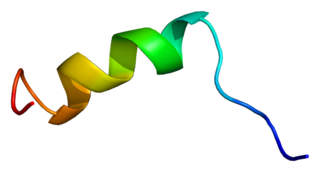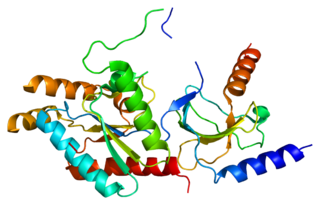
LRRTM1 is a brain-expressed imprinted gene that encodes a leucine-rich repeat transmembrane protein that interacts with neurexins and neuroligins to modulate synaptic cell adhesion in neurons. As the name implies, its protein product is a transmembrane protein that contains many leucine rich repeats. It is expressed during the development of specific forebrain structures and shows a variable pattern of maternal downregulation.

Latrophilin 3 is a protein that in humans is encoded by the ADGRL3 gene.

G protein-coupled receptor 50 is a protein which in humans is encoded by the GPR50 gene.

Sodium channel protein type 2 subunit alpha , is a protein that in humans is encoded by the SCN2A gene. Functional sodium channels contain an ion conductive alpha subunit and one or more regulatory beta subunits. Sodium channels which contain sodium channel protein type 2 subunit alpha are sometimes called Nav1.2 channels.

Voltage-dependent L-type calcium channel subunit beta-2 is a protein that in humans is encoded by the CACNB2 gene.

The Abelson helper integration site 1 (AHI1) is a protein coding gene that is known for the critical role it plays in brain development. Proper cerebellar and cortical development in the human brain depends heavily on AHI1. The AHI1 gene is prominently expressed in the embryonic hindbrain and forebrain. AHI1 specifically encodes the Jouberin protein and mutations in the expression of the gene is known to cause specific forms of Joubert syndrome. Joubert syndrome is autosomal recessive and is characterized by the brain malformations and mental retardation that AHI1 mutations have the potential to induce. AHI1 has also been associated with schizophrenia and autism due to the role it plays in brain development. An AHI1 heterozygous knockout mouse model was studied by Bernard Lerer and his group at Hadassah Medical Center in Jerusalem to elucidate the correlation between alterations in AHI1 expression and the pathogenesis of neuropsychiatric disorders. The core temperatures and corticosterone secretions of the heterozygous knockout mice after exposure to environmental and visceral stress exhibited extreme repression of autonomic nervous system and hypothalamic-pituitary-adrenal responses. The knockout mice demonstrated an increased resilience to different types of stress and these results lead to a correlation between emotional regulation and neuropsychiatric disorders.

Gamma-aminobutyric acid receptor subunit alpha-6 is a protein that in humans is encoded by the GABRA6 gene.

CHRNA7-FAM7A fusion protein is a protein that in humans is encoded by the CHRFAM7A gene.

Dyslexia-associated protein KIAA0319 is a protein which in humans is encoded by the KIAA0319 gene.

Nodal modulator 1 is a protein that in humans is encoded by the NOMO1 gene.

39S ribosomal protein L40, mitochondrial is a protein that in humans is encoded by the MRPL40 gene.

CAAX box protein 1 is a protein that in humans is encoded by the FAM127A gene.

Quinone oxidoreductase-like protein 1 is an enzyme that in humans is encoded by the CRYZL1 gene.

28S ribosomal protein S21, mitochondrial is a protein that in humans is encoded by the MRPS21 gene.

Teashirt homolog 3 is a protein that in humans is encoded by the TSHZ3 gene. In mice, it is a necessary part of the neural circuitry that controls breathing. The gene is also a homolog of the Drosophila melanogaster teashirt gene, which encodes a zinc finger transcription factor important for development of the trunk.

Gamma-aminobutyric acid receptor subunit gamma-1 is a protein that in humans is encoded by the GABRG1 gene. The protein encoded by this gene is a subunit of the GABAA receptor.

Gamma-aminobutyric acid receptor subunit theta is a protein that in humans is encoded by the GABRQ gene. The protein encoded by this gene is a subunit of the GABAA receptor.

ATP-binding cassette sub-family A member 13 also known as ABCA13 is a protein that in humans is encoded by the ABCA13 gene on chromosome 7. It belongs to the wide ATP-binding cassette family of proteins. The protein contains 5058 residues, and is currently the largest known protein of the ABC family.

Protocadherin Fat 4, also known as cadherin family member 14 (CDHF14) or FAT tumor suppressor homolog 4 (FAT4), is a protein that in humans is encoded by the FAT4 gene.

Single-stranded DNA-binding protein 4 is a protein that in humans is encoded by the SSBP4 gene.


















